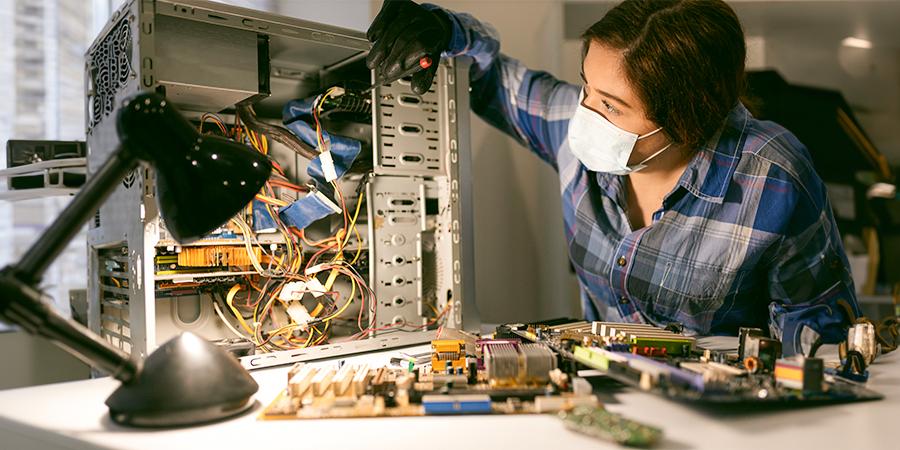Electrical Engineering in Space: Powering Satellites and Spacecraft
Amid the boundless reaches of space, where the sun stands as the solitary wellspring of light and energy, the spotlight shines on electrical engineering. Satellites and spacecraft lean heavily on state-of-the-art electrical systems to operate and flourish in the unforgiving environs of the cosmos. This is the right time to pursue a BTech in Electrical Engineering from a top university like NSHM Knowledge Campus.
-
Harnessing Solar Power
In space, the sun stands out as a primary source of energy. Solar panels take the spotlight as dependable workhorses in numerous space missions, effectively transforming sunlight into electrical power. These panels typically comprise semiconductor materials, such as silicon, which possess the ability to generate electricity when exposed to photons emitted by the sun. Engineers have successfully engineered solar panels that demonstrate outstanding efficiency and durability, enabling consistent operation despite the extreme temperature fluctuations encountered in the vacuum of space.
Furthermore, advancements in solar panel design extend beyond the traditional. Innovative concepts like flexible and rollable solar arrays have surfaced, with the aim of optimising power generation while concurrently reducing the weight and dimensions of the panels. These breakthroughs hold significant importance in providing the necessary power to satellites and spacecraft during their voyages through the cosmos. In esteemed institutes like NSHM, a BTech College in Durgapur, the mentors are up to date with these advancements and impart the needed knowledge for future scientists of space.
-
Energy Storage Solutions
Spacecraft must store excess energy generated during periods of sun exposure to ensure continuous operation during the dark side of their orbits. In response to this challenge, electrical engineers have spearheaded the development of sophisticated energy storage solutions, encompassing high-capacity batteries and supercapacitors. These energy storage systems serve as steadfast power sources during periods of eclipse and when spacecraft find themselves in the shadow of celestial bodies.
Moreover, the pursuit of cutting-edge energy storage technologies is an ongoing endeavour. Innovations like flywheel energy storage and advanced fuel cells are constantly under exploration. These advancements are geared towards amplifying the resilience and efficiency of space missions, empowering them to execute more extensive research and exploration endeavours.
-
Power Management and Distribution
Efficient power management and distribution are essential for space missions’ success. Electrical engineers meticulously design power distribution systems to ensure electricity reaches all subsystems and instruments on board spacecraft. These systems necessitate a high degree of reliability, fault tolerance, and adaptability to accommodate shifting power requirements.
Furthermore, the presence of intelligent power management systems is imperative for optimising power consumption while minimising wastage. These systems can selectively power down non-essential systems during low-power periods, ensuring that vital instruments and communication systems operate without interruption.
-
Radiation and Thermal Challenges
Space poses unique challenges for electrical engineers. High radiation levels in cosmic rays and solar radiation can damage electrical components over time. Engineers must design radiation-hardened electronics to withstand these extreme conditions, ensuring the longevity and reliability of the spacecraft.
Additionally, the extreme temperatures of space, ranging from extreme cold to scorching heat, require advanced thermal management systems to regulate temperature and prevent overheating or freezing of critical components. Electrical engineers work hand in hand with thermal experts to develop robust solutions for these challenges. A BTech in Electrical Engineering from a top university like NSHM Knowledge Campus, Durgapur prepares its graduates with all the needed knowledge to tackle such challenges.
-
Innovations in Propulsion Systems
In addition to its primary focus on power generation and distribution, electrical engineering also assumes a pivotal role in the advancement of propulsion systems for spacecraft. Electric propulsion systems, exemplified by ion and Hall-effect thrusters, depend on electrical power to accelerate charged particles and generate propulsive force. These highly efficient systems boast extended operational capabilities, rendering them ideal for prolonged missions such as interplanetary travel.
Furthermore, electrical engineers esteemed institutes like NSHM, Top BTech College in Durgapur, can occupy the forefront in the development of groundbreaking propulsion technologies, including solar sails and electromagnetic propulsion. These innovations harness electrical principles to provide propulsion without the conventional reliance on chemical rockets. These technologies hold the potential to redefine space travel by reducing dependence on finite chemical propellants and facilitating swifter and more efficient voyages through the cosmos.
-
The Significance of Redundancy
In the unforgiving environment of space, redundancy is a cornerstone of spacecraft design. Electrical engineers are crucial in ensuring critical systems have backup components or redundant subsystems. This redundancy is vital for mission success, as it can help mitigate the impact of component failures, ensuring that the spacecraft continues to function even in the face of adversity.
Redundant electrical systems are carefully designed and tested to ensure that they can seamlessly take over if the primary system encounters issues. This reliability factor is paramount for the success of long-duration missions and deep-space exploration, where repair or maintenance is impossible.
In the vast expanse of space, electrical engineering plays a pivotal role in powering satellites and spacecraft. From harnessing solar power to developing advanced energy storage solutions, electrical engineers have continually pushed the boundaries of innovation to enable missions beyond Earth’s atmosphere. By diligently managing and distributing power, employing components resistant to radiation, deploying sophisticated thermal control systems, incorporating cutting-edge propulsion technologies, and maintaining a steadfast commitment to redundancy, these engineers guarantee the dependability of space missions, even when confronted with the most demanding conditions.
As we continue our fruitful endeavours to explore and extend our reach into the cosmos, the indispensable role played by electrical engineers will remain in the vanguard, guiding the successes of missions that unravel the mysterious enigmas of the universe and chart the course for forthcoming exploration. The synergy between electrical engineering and space exploration stands as a testament to human ingenuity and our resolute dedication to pushing boundaries, one electrical circuit at a time. With each new mission, electrical engineers continue to redefine the realm of possibilities in the boundless expanse of space, drawing us ever closer to comprehending the cosmos and our place within it.







